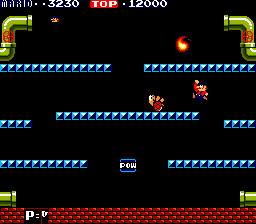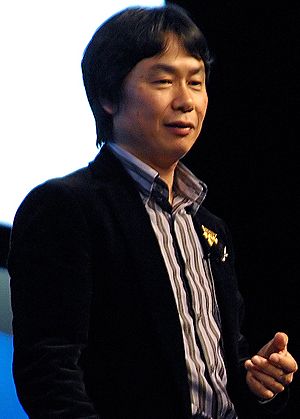Mario Bros. facts for kids
Quick facts for kids Mario Bros. |
|
|---|---|
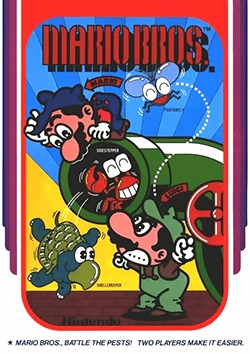
North American arcade flyer
|
|
| Developer(s) |
Arcade, Famicom/NES
Nintendo R&D1 NES
|
| Publisher(s) |
2600, 5200
|
| Director(s) | Shigeru Miyamoto |
| Producer(s) | Gunpei Yokoi |
| Designer(s) |
|
| Composer(s) | Yukio Kaneoka |
| Series | Mario |
| Platform(s) |
Arcade
|
| Release date(s) |
March 1983
Arcade
Famicom/NES
2600, 5200
PC-88
FM-7
PC-8001
CPC
7800
C64
Spectrum
Atari 8-bit
e-Reader
Game Boy Advance
|
| Genre(s) | Platform |
| Mode(s) | Single-player, multiplayer |
Mario Bros. is a classic platform game from 1983. It was made by Nintendo and designed by Shigeru Miyamoto and Gunpei Yokoi. In this game, you play as the famous Italian plumber brothers, Mario and Luigi. They work in the sewers, fighting strange creatures like turtles and crabs. This game was the start of the huge Mario series we know today!
Mario Bros. was first released in arcades. Later, it came out on the Famicom and NES. Many ideas from Mario Bros. became important parts of future Mario games. These include collecting spinning coins, flipping turtles onto their backs, and the character Luigi.
You can still play Mario Bros. today! An updated version is a minigame in the Super Mario Advance series and Mario & Luigi: Superstar Saga. The NES version is available on Wii and Wii U Virtual Console. The original arcade game is also on Nintendo Switch as part of the Arcade Archives series.
Contents
How to Play Mario Bros.
In Mario Bros., you control either Mario or Luigi. They are plumbers who need to clear out strange creatures from the sewers. Your goal is to defeat all enemies in each stage.
Game Controls and Movement
The game is simple to play. You can only run and jump. Unlike later Mario games, you cannot jump on enemies to defeat them directly. You must first flip them over. Each stage has platforms and pipes in the corners. There is also a "POW" block in the middle. If you go off one side of the screen, you will reappear on the other side.
Defeating Enemies
To defeat an enemy, you must hit the platform directly below it. This flips the enemy onto its back. Once an enemy is flipped, you need to kick it to make it disappear. If you wait too long, the enemy will flip back over and recover. You earn points for defeating enemies. Bonus coins also appear from the pipes after enemies are gone.
Types of Enemies
There are different enemies that come out of the pipes:
- Shellcreeper: These are turtle-like creatures.
- Sidestepper: These are crab-like enemies.
- Fighter Fly: This enemy moves by jumping. You can only flip it when it is touching a platform.
- Slipice: This enemy turns platforms into slippery ice.
There are also fireballs that float around the screen. They do not stick to platforms. The "POW" block is a special item. When you hit it, all enemies on a platform or the floor get flipped over. But be careful, you can only use the "POW" block three times!
Game Hazards
In later stages, icicles start to form under platforms. They can fall down. You lose a life if you touch an unflipped enemy, a fireball, or a falling icicle. The game ends when you lose all your lives.
Making the Game: Development Story
Mario Bros. was created by Shigeru Miyamoto and Gunpei Yokoi. They were also key developers for the game Donkey Kong. In Donkey Kong, Mario would die if he fell too far. For Mario Bros., Yokoi suggested that Mario should be able to fall from any height. Miyamoto wasn't sure at first, but he agreed. He thought it would be fun for Mario to have some special abilities.
They designed a test version where Mario was "jumping and bouncing around." This made them happy. The idea of hitting enemies from below came from Yokoi. He noticed it would work well with the game's multiple floors. At first, it was too easy to defeat enemies this way. So, they added the rule that players had to touch the flipped enemies to defeat them. This is also how the turtle enemy was created. They thought of it as an enemy that could only be hit from below.
Mario's Job and Setting
Mario wore overalls, a hat, and had a thick mustache in Donkey Kong. Because of this, Miyamoto thought he should be a plumber instead of a carpenter. The game's setting, a big network of giant pipes, also fit the plumber idea. The pipes were inspired by Japanese comics, called manga. Miyamoto said these comics often showed waste areas with pipes. In the game, pipes helped enemies enter and leave the stage. This stopped too many enemies from piling up at the bottom.
The green color of the pipes was chosen because Nintendo had a limited color palette. Miyamoto wanted to keep the game colorful. He found that green worked best when two shades of it were combined.
Introducing Luigi
Mario Bros. was the first game to introduce Mario's brother, Luigi. Luigi was created for the two-player mode. He was made by simply changing Mario's colors. The idea for a two-player mode and some gameplay elements came from another game called Joust.
The game's music was composed by Yukio Kaneoka. The starting music is from Mozart's famous song Eine kleine Nachtmusik. This song has been used in other video games too.
Game Releases and Versions
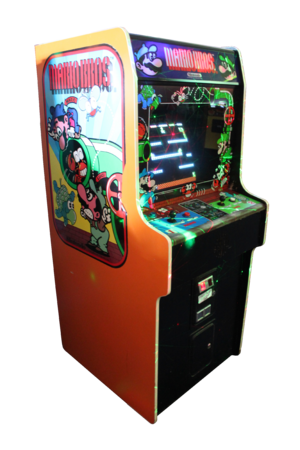
Mario Bros. first came out in North American arcades in March 1983. It was released in Japan in June 1983. When it first came out, some people thought it was the third game in the Donkey Kong series.
Home Console Versions
Many companies made versions of Mario Bros. for home video game systems. These included the Atari 2600, Atari 5200, Atari 8-bit computers, Atari 7800, Amstrad CPC, and ZX Spectrum. The Commodore 64 had two versions. Only the Atari 8-bit computer version included the falling icicles.
Nintendo and Intelligent Systems made a version for the Nintendo Entertainment System (NES). This version came out in North America in June 1986.
Modern Re-releases
The NES version of Mario Bros. has been re-released on modern systems. You can play it on the Wii, Nintendo 3DS, and Wii U through the Virtual Console service. The original arcade version of Mario Bros. was released on the Nintendo Switch in September 2017. The NES version was also available when the Nintendo Classics service launched.
Mario Bros. has also been included as a bonus game in other Nintendo titles. For example, it's a two-player minigame in Super Mario Bros. 3. It's also a single-player mode in the Game Boy Advance's Super Mario Advance series and Mario & Luigi: Superstar Saga.
Legacy of Mario Bros.
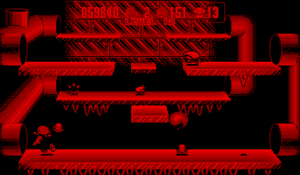
Mario Bros. was a very important game for Nintendo. It introduced many ideas that became key parts of the Mario universe.
Other Games Inspired by Mario Bros.
In 1984, Hudson Soft made two different games based on Mario Bros.. One was Mario Bros. Special, which had new stages and gameplay. The other was Punch Ball Mario Bros., which added a new way to stun enemies by punching small balls.
A new version of the game was planned for the Virtual Boy system in 1994. It was called Mario Bros. VB. This version was never released. However, some of its ideas were used in Mario Clash (1995).
Super Mario 3D World for the Wii U includes a special version of Mario Bros. called Luigi Bros. This version is based on the NES game. It stars Luigi in his modern green outfit. The second player still uses Luigi's original colors.
See also
 In Spanish: Mario Bros. para niños
In Spanish: Mario Bros. para niños


